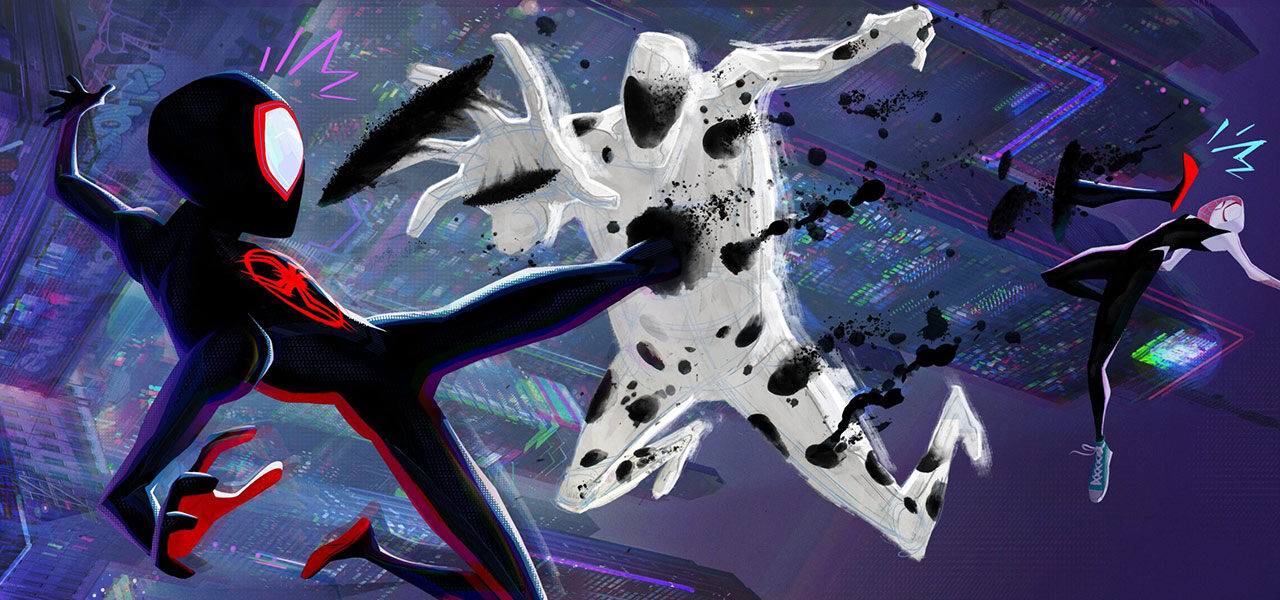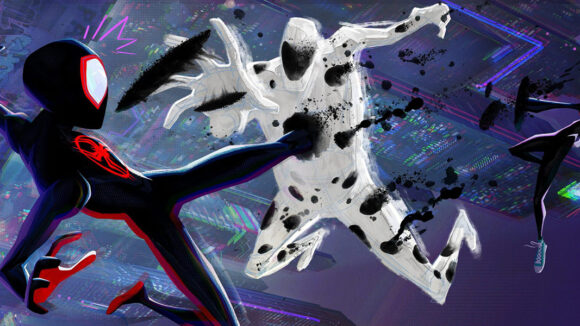

‘Spider-Man: Across The Spider-Verse’ Directors Discuss Their Sequel (Video Interview)
The wild, maximalist Spider-Man: Into The Spider-Verse’s success was spectacular, its innovative style helping Miles Morales swing his way into becoming a household name.
Perhaps the most striking feature of the Sony Imageworks produced film directed by the trio of Rodney Rothman, Peter Ramsay and Bob Persichetti, was an experimental blend of the visual languages of comic books and animation through mimicry of methods like the Ben Day process and “Kirby Krackle.” The film dropped jaws with its use of comic book onomatopoeia as well as an adaptation of traditional 2d techniques and unique nuances to 3d cg animation. Into The Spider-Verse still stands apart for its willingness to play with the textures of what it was adapting rather than just plot in the various art styles depicting its various Spider-People – the anime-inspired Peni Parker, the monochrome Spider-Noir, and so many more.
The artist’s hand takes similar priority in the upcoming sequel, Spider-Man: Across the Spider-Verse. In a presentation at the 2022 Annecy Animation Festival, sequel directors Joaquim Dos Santos (director, Legend of Korra, Voltron), Kemp Powers (co-director/writer, Soul; writer, One Night in Miami), and Justin K. Thompson (production designer, Into the Spider-Verse, Cloudy With a Chance of Meatballs) highlighted how they’re expanding on the first’s “spirit of experimentation.” Afterwards, they sat down with Cartoon Brew, which was the only U.S. media outlet to conduct a video interview with the dirctors. Watch it below:
Using footage previously shown at Cinemacon, the directors at Annecy gave a more detailed look at a clip featuring the first film’s Gwen Stacy and her father George squaring off with The Vulture (who is very, very Italian here) at the Guggenheim. The trio used to the clip to discuss the various methods being used to visually define the second film. The main example was a watercolor simulation tool, used in Gwen’s world Earth-65 to emulate the mood and style of the comic from which the character is adapted.
Following a clip of Miles and his family at a parent-teacher meeting, the directors highlighted how they wished to continue their adaptation of comic book aesthetics to 3d animation, in part by recruiting comic book artists on the visual development teams to give pointers on how to use their unique inking and drawing techniques.

Toward the end of the presentation, the directors share the day’s biggest announcement. Alongside a first-look image (pictured above), the presenters revealed that Spider-Man C-lister The Spot – imagined by the animators as a “rough drawing” in human form with a tool that simulates moving, shimmering ink drops all over his skin – would play the foil to the multiple Spider-People.
Catching up with the three directors in Annecy, we discussed the choices behind picking this particularly odd villain, their multitude of comic book collaborators, and how the film’s new dimensions diverge, or don’t, from the work they’ve done before.

.png)